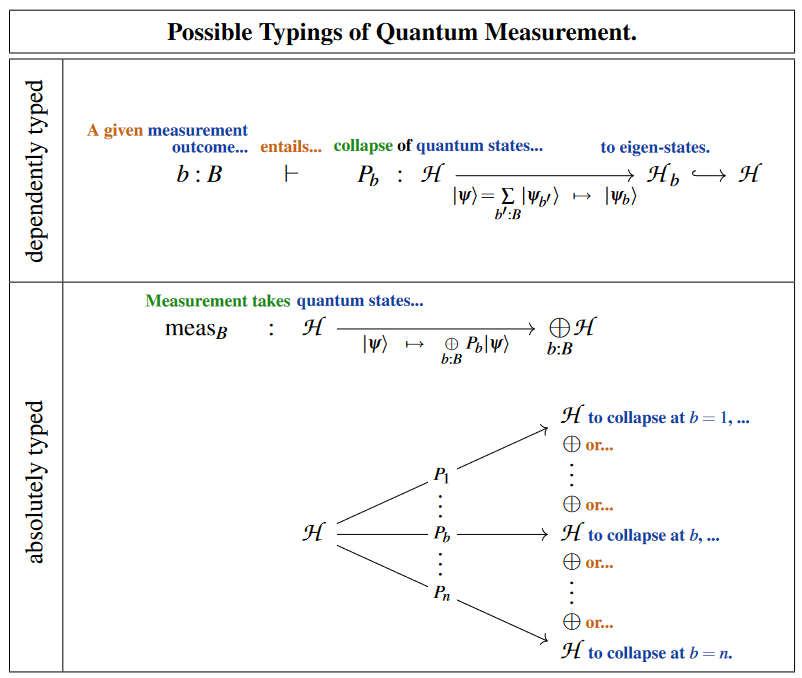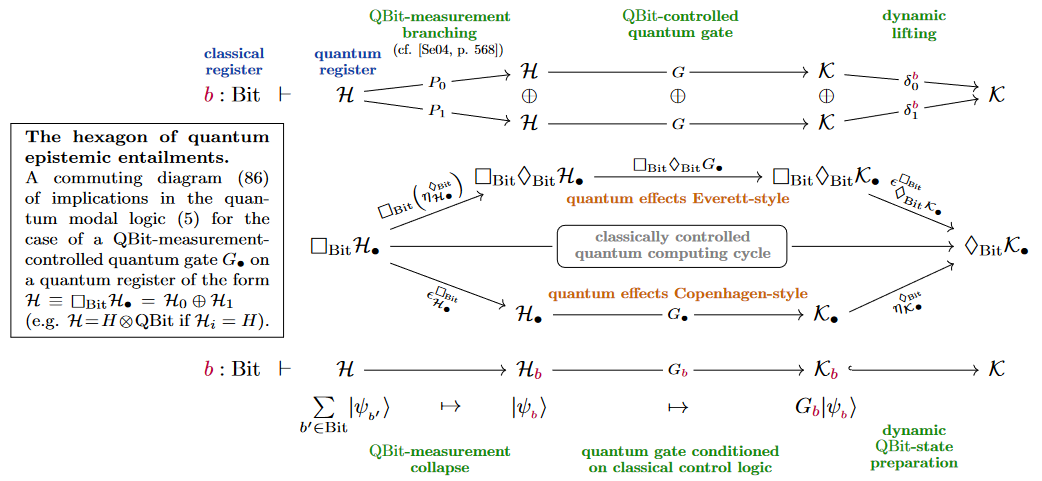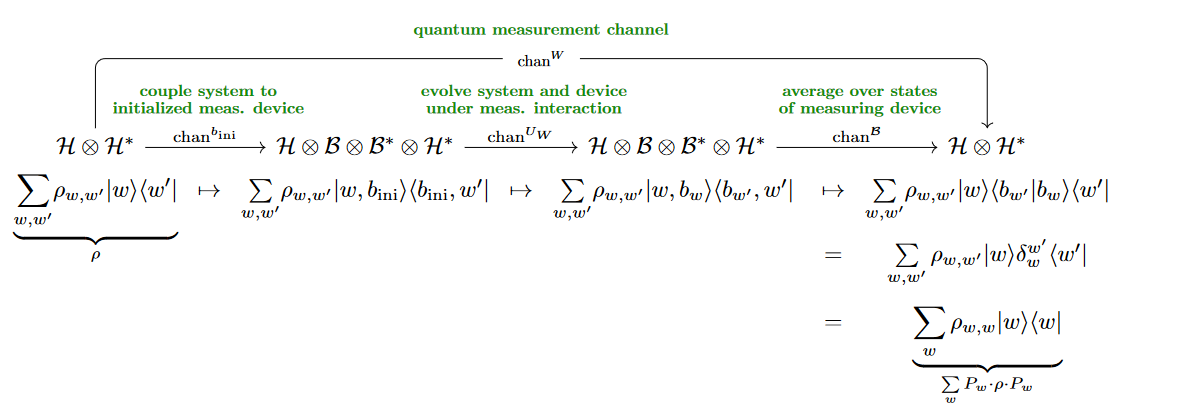nLab quantum measurement
Context
Quantum systems
-
quantum algorithms:
Quantum measurement
Idea
Quantum measurement is measurement in quantum mechanics.
The “projection postulate” of quantum physics asserts (von Neumann 1932; Lüders 1951) that:
-
measurement of quantum states is with respect to a choice of orthonormal linear basis of the given Hilbert space of pure quantum states;
-
the result of measurement on pure quantum states is
-
a random value ;
-
the “collapse” of the quantum state being measured by orthogonal projection to the linear span of the th basis state.
-
In terms of mixed quantum states represented by density matrices, this prescription translates into a quantum operation which is given by a positive-operator valued measure (this is what Lüders (1951) first wrote down).
There are different ways to type the quantum measurement, taking into account the non-deterministic nature of its outcome:
-
Regarding the direct sum of Hilbert spaces as the logical disjunction (“or”) of quantum logic, one may regard measurement as being the linear map into the direct sum whose th component is .
This choice of typing appears (briefly) in Selinger 2004, p. 39, in a precursor discussion that led to the formulation of the quantum programming language Quipper.
-
Regarding the measurement outcome as the observed context of the actual quantum collapse, one may regard the collapse projection as dependently typed.
Getting from previous option back to this one is known in the the Quipper-community as dynamic lifting (namely “of the measured bits back into the context”)

Both of these options naturally emerge and are naturally unified in the “Quantum Modal Logic” inherent to dependent linear type theory: This is discussed at quantum circuits via dependent linear types.

Properties
Various
Environmental representation of measurement channels
By the general theorem about environmental representations of quantum channels, every quantum channel on a quantum system may be decomposed as
-
coupling of to an environment/bath system ,
-
unitary evolution of the composite system ,
-
averaging the result over the environment states.
The way this works specifically for quantum measurement channels has precursor discussion von Neumann 1932 §VI.3 and received much attention in discussion of quantum decoherence following Zurek 1981 and Joos & Zeh 1985 (independently and apparently unkowingly of the general discussion of environmental representations in Lindblad 1975).
Concretely,
(we shall restrict attention to finite-dimensional Hilbert spaces not to get distracted by technicalities that are irrelevant to the point we are after)
if (we use bra-ket notation) denotes the initial state of a “device” quantum system then any notion of this device measuring the given quantum system (in its measurement basis , ) under their joint unitary quantum evolution should be reflected in a unitary operator under Zurek 1981 (1.1), Joos & Zeh 1985 (1.1.), following von Neumann 1932 §VI.3, review includes Schlosshauer 2007 (2.51):
-
the system remains invariant if it is purely in any eigenstate of the measurement basis,
-
while in this case the measuring system evolves to a corresponding “pointer state” :
for and distinct elements of an (in practice: approximately-)orthonormal basis for . (There is always a unitary operator with this mapping property (1), for instance the one which moreover maps and is the identity on all remaining basis elements.)
But then the composition of the corresponding unitary quantum channel with the averaging channel over is indeed equal to the -measurement quantum channel on (cf. eg. Schlosshauer 2007 (2.117), going back to Zeh 1970 (7)), as follows:

The “measurement problem”
In the context of interpretation of quantum mechanics it is common to speak of the “measurement problem” when referring to the tension between regarding quantum physics as a probabilistic theory and the idea of realism.
Namely – by the above – a quantum measurement is formally reflected in a change of probabilities. But since in any given measurement experiment one definite outcome is observed, one may wonder how that particular outcome was actually chosen, given that the theory only gives its probability.
(…)
Related concepts
References
General
The original axiomatization of quantum measurement via the projection postulate:
-
John von Neumann, §III.3, §V.1 and §VI of:
Mathematische Grundlagen der Quantenmechanik (German) (1932, 1971) [doi:10.1007/978-3-642-96048-2]
Mathematical Foundations of Quantum Mechanics Princeton University Press (1955) [doi:10.1515/9781400889921, Wikipedia entry]
-
Über die Zustandsänderung durch den Meßprozeß, Ann. Phys. 8 (1951) 322–328 [doi:10.1002/andp.19504430510]
Concerning the state-change due to the measurement process, Ann. Phys. 15 9 (2006) 663-670 [pdf, pdf]
Review and discussion:
-
Erhard Scheibe, §VI of: The logical analysis of quantum mechanics, Pergamon Press, Oxford (1973)
-
Roland Omnès, §8 of: The Interpretation of Quantum Mechanics, Princeton University Press (1994) [ISBN:9780691036694]
(with an eye towards interpretations of quantum mechanics)
-
Heinz-Peter Breuer, Francesco Petruccione, §2.4 and Part V in: The Theory of Open Quantum Systems, Oxford University Press (2007) [doi:10.1093/acprof:oso/9780199213900.001.0001]
(form the perspective of open quantum systems and with focus on relativistic field theory)
-
Joseph M. Renes, §A of: Quantum Information Theory (2015) [pdf] De Gruyter (2022) [doi:10.1515/9783110570250]
-
Klaas Landsman, Section 11: of Foundations of quantum theory – From classical concepts to Operator algebras, Springer Open 2017 (doi:10.1007/978-3-319-51777-3, pdf)
See also:
- Wikipedia: Measurement in quantum mechanics
In view of dynamical quantum decoherence:
- Maximilian Schlosshauer, Decoherence, the measurement problem, and interpretations of quantum mechanics, Rev. Mod. Phys. 76 (2004) 1267-1305 [arXiv:quant-ph/0312059, doi:10.1103/RevModPhys.76.1267]
On experimental realization in cloud chambers:
-
Jonathan F. Schonfield: The First Droplet in a Cloud Chamber Track, Found Phys 51 47 (2021) [doi:10.1007/s10701-021-00452-x]
-
Jonathan F. Schonfield: Measured distribution of cloud chamber tracks from radioactive decay: A new empirical approach to investigating the quantum measurement problem, Open Physics 20 1 (2022) [doi:10.1515/phys-2022-0009]
See also:
- Jürg Fröhlich, Zhou Gang, On the Evolution of States in a Quantum-Mechanical Model of Experiments [arXiv:2212.02599]
Discussion in the refined context of (local algebraic) quantum field theory on Lorentzian manifolds:
-
Christopher J. Fewster, Rainer Verch, Measurement in Quantum Field Theory in Encyclopedia of Mathematical Physics 2nd ed, Elsevier (2024) [arXiv:2304.13356]
-
Jan Mandrysch, Miguel Navascués: Quantum Field Measurements in the Fewster-Verch Framework [arXiv:2411.13605]
-
Christopher J. Fewster: Lectures on measurement in quantum field theory [arXiv:2504.17437]
See also:
- Samuel Fedida: Einstein causality of quantum measurements in the Tomonaga-Schwinger picture [arXiv:2506.14693]
Formalization
Brief mentioning of typing and categorical semantics of quantum measurement
- Peter Selinger, Benoît Valiron, p. 143 of: Quantum Lambda Calculus, Semantic Techniques in Quantum Computation, Cambridge University Press (2009) 135-172 [doi:10.1017/CBO9781139193313.005, pdf]
in the quantum programming language QPL/Quipper:
- Peter Selinger, p. 39 of: Towards a quantum programming language, Mathematical Structures in Computer Science 14 4 (2004) 527–586 [doi:10.1017/S0960129504004256, pdf, web]
Discussion of quantum measurements in terms of quantum information theory via dagger-compact categories, by Frobenius algebra-structures and the quantum reader monad:
-
Bob Coecke, Duško Pavlović, Quantum measurements without sums, in: Louis Kauffman, Samuel Lomonaco (eds.), Mathematics of Quantum Computation and Quantum Technology, Taylor & Francis (2008) 559-596 [arXiv:quant-ph/0608035, doi:10.1201/9781584889007]
-
Bob Coecke, Eric Oliver Paquette, POVMs and Naimark’s theorem without sums, Electronic Notes in Theoretical Computer Science 210 (2008) 15-31 [arXiv:quant-ph/0608072, doi:10.1016/j.entcs.2008.04.015]
-
Bob Coecke, Eric Paquette, Duško Pavlović, Classical and quantum structures (2008) [pdf, pdf]
-
Bob Coecke, Eric Oliver Paquette, Duško Pavlović, Classical and quantum structuralism, in: Semantic Techniques in Quantum Computation, Cambridge University Press (2009) 29-69 [arXiv:0904.1997, doi:10.1017/CBO9781139193313.003]
-
Bob Coecke, Duško Pavlović, Jamie Vicary, A new description of orthogonal bases, Mathematical Structures in Computer Science 23 3 (2012) 555- 567 [arXiv:0810.0812, doi:10.1017/S0960129512000047]
-
Chris Heunen, Martti Karvonen, Exp. 6.5 in: Monads on dagger categories, Theory and Applications of Categories 31 35 (2016) 1016-1043 [arXiv:1602.04324, TAC:31-35]
and the evolution of the “classical structures”-monad into the “spider”-diagrams (terminology for special Frobenius normal form, originating in Coecke & Paquette 2008, p. 6, Coecke & Duncan 2008, Thm. 1) of the ZX-calculus:
-
Bob Coecke, Ross Duncan, §3 in: Interacting Quantum Observables, in Automata, Languages and Programming. ICALP 2008, Lecture Notes in Computer Science 5126, Springer (2008) [doi:10.1007/978-3-540-70583-3_25]
-
Aleks Kissinger, §§2 in: Graph Rewrite Systems for Classical Structures in -Symmetric Monoidal Categories, MSc thesis, Oxford (2008) [pdf, pdf]
-
Aleks Kissinger, §4 in: Exploring a Quantum Theory with Graph Rewriting and Computer Algebra, in: Intelligent Computer Mathematics. CICM 2009, Lecture Notes in Computer Science 5625 (2009) 90-105 [doi:10.1007/978-3-642-02614-0_12]
-
Bob Coecke, Ross Duncan, Def. 6.4 in: Interacting Quantum Observables: Categorical Algebra and Diagrammatics, New J. Phys. 13 (2011) 043016 [arXiv:0906.4725, doi:10.1088/1367-2630/13/4/043016]
Textbook account (though without mentioning the monad structure) in:
- Chris Heunen, Jamie Vicary, around Lem. 5.61 of: Categories for Quantum Theory, Oxford University Press (2019) [ISBN:9780198739616]
Generalization to Hilbert bundles:
- Chris Heunen, Manuel L. Reyes?, Frobenius Structures Over Hilbert -Modules, Commun. Math. Phys. 361 (2018) 787–824 [doi:10.1007/s00220-018-3166-0, arXiv:1704.05725]
The Measurement Problem
The article
- Klaas Landsman, Robin Reuvers, A Flea on Schrödinger’s Cat, Found. Phys. 43, 373-407 (2013) (arXiv:1210.2353, pdf)
points out that for symmetric systems with a symmetric ground state, already a tiny perturbation mixing the ground state with the first excited state causes spontaneous symmetry breaking in a suitable limit, and suggests that this already resolves the measurement problem.
See also
- David Wallace, The Quantum Measurement Problem: State of Play (arXiv:0712.0149)
Last revised on June 26, 2025 at 11:10:31. See the history of this page for a list of all contributions to it.